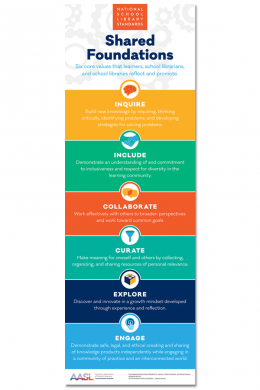Using the perspective and context of a KQ article I explored, compare/contrast the AASL and ISTE standards. What differences do you see? What similarities? How do you envision these standards working together?
So here's the thing...after my years in education, I have learned that to get everyone within a school to do their part, teachers must buy into what we're selling. After reading Deborah Ehler-Hansen and Casey O'Meara's (2019), Portrait of a Graduate and the National School Library Standards I was about 89% sold into believeing the standards are the thing that will help our students. I appreciated how they not only showed how the standards were broken into I Can statements, but they were also put into a rubric to help show students proficiency level. But, I'd like to see some data. Where are the numbers that shows us that these standards are great, purposeful, useful, and that thing that will make our gradutes ready for this world with the abilities to think, create, share, and always grow?
Well, here you go... It may not be numbers, but this video is evidence directly from students. Watch as students as young as 3rd graders explain how some of these standards are beneficial and helping them become better thinkers and problem solvers.
 |
Photo of the Shared Foundations of the AASL Standards integration |
The ISTE standards seem to be geared more toward technological advancement while the AASL standards only specifically mentions the technolgy standard in the Engage domain. However, that is not to say that the AASL doesn't see the importance of technology, though not explictly mentioned it is implied. Again, that is just the word choice of the standards. It also makes sense that ISTE has technology weaved through its standards when you considering the word technology is in its name. Nonetheless, Both set of standards work together to increase students critical thinking, digital literacy, problem, solving skills, and ability to access resources. Each need to be taught and/or utilized to create powerful, engaging lessons for students.
STANDARDS ALIGNMENT
The AASL and ISTE standards are necessities in a school library. The standards provide the teacher librarians with a framework of what to teach and ensures the students are recieving all the information. Upon reviewing both standards I can appreciate the similarites, but question some of the differences. However simialr or different the Shared Foundations are used regardless of the standard because they are the core values promoted and reflected by learners, school librarians, and the school libraries (AASL, 2020).
References
American Association of School Libraries (2017). Learners interprets the standards: Inquire. YouTube. https://www.youtube.com/watch?v=QlGLPyAFqVc&t=12s
American
Association of School Libraries (2018). National school library standards crosswalks. AASL. https://standards.aasl.org/wp-content/uploads/2018/08/180828-aasl-standards-crosswalk-iste.pdf
American
Association of School Libraries (2020). Purpose & structure. American
Library Association. https://aasl.ala.org/standards/overview/

I love your opening in this blog post. It makes me want to keep reading and also go back to read the article you choose from Knowledge Quest. Your questions are also spot on. As a teacher, I always want to see the data to back up claims, the proof that shows me it works so then I can relay that to stakeholders and parents.
ReplyDeleteI love that you also included the video with student testimony regarding the AASL standards. I feel like as school librarians we need to do a better job of explaining the standards and performance indicators to the students. I know that until taking courses toward my MLIS I had not realized there were standards at all. Displaying the 'I can" statements and reviewing the end goals which correlate to both the AASL and ISTE standards would be very beneficial at the beginning of a lesson with students so they know what they are working toward. It would make them more aware of what they should be able to do and if we start doing this at a younger age, eventually as they reach high school it will become commonplace and build on one another. Vertical alignment and scaffolding.
Thank you for sharing!
Carol Gurrieri
Your blog post makes me want to redo mine! It is full of energy and I love how you bring in other resources, like the video to help make your point that students benefit.
ReplyDeleteI cannot agree more with you that teacher buy-in is a must and there must be proof that something is going to work before a commitment is made. This is often really hard because as you know we are constantly changing standards and curriculum in core classes. As a future librarian, it would be great if at all levels in a district there are a set of standards that are taught and students and teachers are aware of the goal, similar to a couple of the article in KQ this week. I would never want to put more work on a teacher, but if everyone on a campus was aware of the ISTE and AASL standards and the school committed to goals around those for all students, teachers can see the added value of the librarian. It would provide us, as librarians, an opportunity for collaboration and to really develop lessons around what is going on in the classroom. As a middle school teacher, I am watching ELA teachers spend less and less time in the library and I feel like if the standards were more prevalent within schools it would build those partnerships. Thank you for sharing! Laura